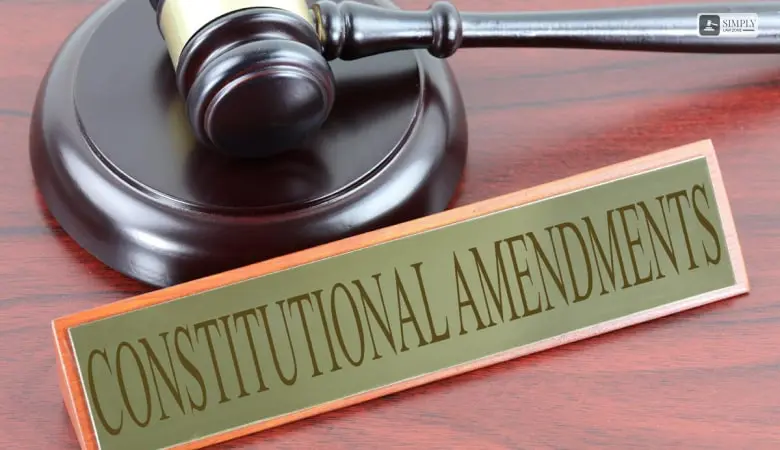
Article 5 of the Constitution deals with yet another protector of the federal character of the United States as a nation and thus, its Constitution too. It stipulates the procedure to amend the Constitution.
The procedure to amend a federal constitution has always been complex. A complex amendment procedure makes sure that no particular state can amend the Constitution according to their needs. The US Constitution is thus, not at all easy to amend.
The American Constitution was adopted in 1788. In the past 234 years, only 27 amendments have been successfully made to the US Constitution. This shows that an amendment made to the Constitution will take into consideration the necessities and requirements of each state.
Now, let us look into the provisions of Article 5 of the United States Constitution!
What Does Article 5 Of The US Constitution Exactly Say?

Article 5 of the US Constitution states that in all such cases where two-thirds of the Senate and House of Representatives deem it necessary, amendments to the Constitution can be proposed.
Such amendment shall be enacted on the ratification by three-fourths of the legislatures of the states or by means of a convention of the three-fourths.
It also establishes that an amendment is only valid if it does not encroach upon the rights of any state.
What Is The Procedure To Amend The Constitution?

Under Article 5 of the US Constitution, multiple amendments have been proposed so far, but only 27 have obtained the desired effect. The first ten amendments, also known as the Bill of rights have been considered to be an integral part of the Constitution. They ensure the civil and personal liberties of the citizens of the US, including their freedoms of free speech, freedom to practice any religion of choice, freedom of the press, etc.
What Are Methods To Place Amendments To The Constitution?
Two distinct means to propose an amendment have been mentioned in Article 5 of the US Constitution.
| The first method is when the necessity of the amendment is shared by two-thirds of both the houses of Congress, the Senate, and the House of Representatives. |
| The second method states that two-thirds of the legislature of the various states have to file an application proposing an amendment. |
The Constitutional Convention that took place in Philadelphia in 1787 makes it quite evident that there was a sort of compromise reached by the two majorities present. The first majority was of the opinion that the National Legislature should have no part to play in the process of amendment. Whereas, the other half help the National Legislature should make the petitions for amendments which could later be ratified by the state legislatures.
The current provisions on amendment thus, provide equally fair chances to both the national and the state legislatures to amend the Constitution. Leaving that power only to the federal government would come off as too rigid, while only the state governments would come off as too flexible.
All Amendments proposed so far have been done by the first method, by two-thirds of both houses of Congress. Founding Father of the United States, Alexander Hamilton argued that the second option of conducting a convention would protect the interests of the state governments against the interference of the union government. However, the second provision is yet to be put into practice.
A joint resolution stating the need for an amendment, once passed by Congress, does not require President’s assent to proceed to the state legislatures for the purpose of ratification. In the case of Hollingsworth v. Virginia(1798), the Supreme Court ruled that the President’s approval or Veto is not required when placing Constitutional Amendments.
Ratification Of Amendments: Article 5 Of The US Constitution

An amendment after being proposed in Congress by a two-thirds majority or even by means of a national convention needs the ratification of three-fourths of the states. There are fifty states in the territory of the US, thirty-eight out of these need to ratify a proposal in order to pass it as an amendment.
Congress is vested with the power to choose if the proposed amendment is to be sent to the state legislatures or to the ratifying conventions. Ratifications obtained by either means are significant.
In the case of United States v. Sprague(1931), the Court ruled that the decision to choose the mode of ratification (conventions or otherwise) lies with Congress in every single amendment.
An amendment is granted complete functioning status as soon as it is ratified by the states.
Are There Any Deadlines To A Ratification?

The Constitution does not provide any express deadline within which the states are to send in their respective ratifications. Thus, in the absence of a deadline, no provisions governing the extension of such a deadline have been talked about.
However, ever since the 18th Amendment was passed in 1917, there has been mentioned a clear deadline to ratify amendments. Such time limits are usually mentioned in the body or the joint resolution of the Amendment.
In the 1921 verdict of Dillon v. Gloss, the Supreme Court held that Congress had every right to prescribe a limitation period within which states were to ratify the proposed Amendment. If such a date is missed, then the proposal shall not remain open to ratification any further.
Extension Of Deadline
Such a deadline can be extended by Congress by a simple majority vote from both houses.
Can All Provisions Of The US Constitution Be Amended?

Certain parts of Article 5 of the US Constitution provide for the restriction of amendments for particular parts of the Constitution. Absolutely non-amendable parts of the Constitution consisted of Article 1 Section 9 Clause 1. This Clause stated that Congress was not to interfere with the provision of importation of slaves.
This provision stopped being in effect after 1808.
Article 1 Section 3 Clause 1 stands strong to date. It stipulates that no amendment is to encroach upon the rights of any state.
And It’s A Wrap!
Article 5 of the US Constitution is peculiar in nature. Although it does lay down the procedure to amend the Constitution, it does not specifically say that Article 5 is itself subject to the same provisions. Experts have said that Article 5 also falls under the purview of amending procedures, even if it has never to date been amended.
Article 5 has been praised by jurists on separate occasions as an organ of bringing about substantial change to the Constitution. The importance of amendments lies in the fact that it allows the supreme law of the land, that is the Constitution to keep up with changing times.
Hope you found the article helpful!
Read Also:


